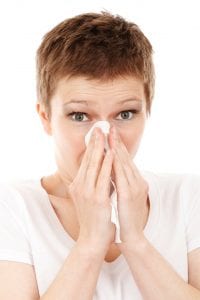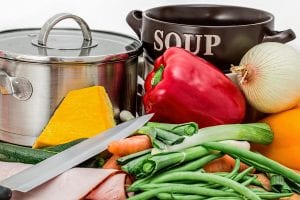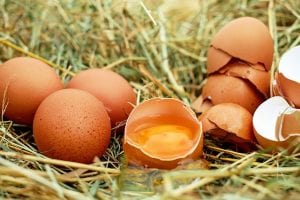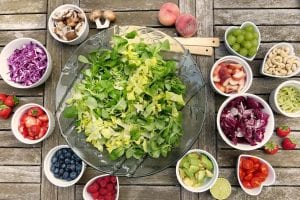The Comprehensive Elimination Diet

There is no diet that is right for everyone. Not GAPS, Paleo, Whole 30, Macrobiotic, or any other number of diets that have been popularized by savvy marketing efforts.
The diet that is best for you is based on your current health, your genetics, your blood type, and your gender.
The diet that fits your needs best today, may not be the best to fit your needs in the next season of life.
How do you know what diet will be the best for you?
The good news is you are your own best doctor. When you use a comprehensive elimination diet, YOU are determining which foods are best for you. How do you make these determinations? Based on your reactions to foods, including your energy, your pain levels, and your moods. It is possible that the foods you can tolerate will expand as your health is optimized.
Not All Elimination Diets are the Same
There are a lot of elimination diets available on the internet, which can cause confusion for someone who thinks they might need to give this a try, but doesn’t know where to begin.
I base mine largely on Dr. Elizabeth Lipski’s elimination diet because that is the diet I learned while earning my master’s degree. However, as I have learned more through years of clinical experience, I have tweaked the original and created my own recommendations. I hope this tool helps you to achieve optimal health.
“Let food be thy medicine and medicine be thy food.”
~ Hippocrates
You may have heard the phrase “Food as Medicine” before. It is true. We can use food as medicine by selecting what is right for us. Food can also be a poison to our body when we make poor choices. Since what is medicine for one may be poison to someone else (hence there not being a single, best diet right for everyone) how do you know what foods to eat?
The Comprehensive Elimination diet is designed to be a tool to help you determine which foods best support your health. Health is optimized when we eat a wide variety of nutrient dense foods. Unfortunately, digesting and absorbing nutrients from certain foods may be difficult for some people.
Why do some people have difficulty with one food (or food group)? It can boil down to our genetics!
 Think about it this way. We know that most people have blue or brown eyes. These two basic colors come in lots of shades, from “ice” blue to black. Of course there are also people with eyes of less common colors such as green and hazel. Liz Taylor was famous for her rare purple eyes.
Think about it this way. We know that most people have blue or brown eyes. These two basic colors come in lots of shades, from “ice” blue to black. Of course there are also people with eyes of less common colors such as green and hazel. Liz Taylor was famous for her rare purple eyes.
Eye color variations is pretty cool all by itself, but the color of your eyes can impact you in ways other than appearance. People with lighter colored eyes often are more sensitive to sunlight. And because they have less pigmentation in their eyes (which protects the eye from ultraviolet light) they tend to have a greater chance of developing cancer in the eye. This could be considered a genetic weakness, one that by wearing proper eye protection (like sunglasses, visors, hats) you can modify.
Some genetic weaknesses make the processing of certain foods, even healthy ones, difficult. Furthermore, processed foods, illness, poor microbiota, stress, and aging can cause gastrointestinal problems. If these GI problems are ignored, we open the door to leaky gut syndrome. Leaky gut syndrome can lead to a host of chronic disease including autoimmune conditions. While following an elimination diet is not quite as simple as remembering to wear sunglasses, it is well worth the effort to return to optimal health.
How Long Does it Take to See Results?
 It is best to follow an elimination diet for three to six weeks. In that time, you should begin to see a resolution of nagging symptoms while following the diet. For example, chronically dripping noses should stop dripping, the chronically aching neck should begin to feel better, post meal fatigue should lessen, energy should increase and more.
It is best to follow an elimination diet for three to six weeks. In that time, you should begin to see a resolution of nagging symptoms while following the diet. For example, chronically dripping noses should stop dripping, the chronically aching neck should begin to feel better, post meal fatigue should lessen, energy should increase and more.
Depending on the depth of the root causes to your health problems, an elimination diet may not provide complete relief. You may need to further support detoxification or provide extensive natural anti-inflammatories to support health. Either way, you’ll know after following this diet for a time if you’ll need to go deeper.
Your short-term reaction to the elimination diet may be challenging at first. For example, if you eat a lot of sugar, the first three to four days of sugar withdrawal are difficult. You may not sleep as well. You may be grumpy. You may have headaches. In my experience, sugar withdrawal is much worse than caffeine withdrawal.
If you have a toxic burden and your body begins to dump toxins, you may feel achy, have headaches, or extreme fatigue. If this happens, be sure to eat animal protein in addition to a wide variety of vegetables and take a pharmaceutical grade multivitamin. Healthy detoxification should not make you feel miserable. Flu-like symptoms are a sign that your detoxification pathways are imbalanced and you need to make a change in what you’re doing. Feeling sick could mean that you’re becoming much more toxic as your body tries to eliminate the toxins. It is important to support all phases of detoxification to prevent overwhelming the body to the point of illness. If you feel flu-like, get the help of a qualified practitioner.
Plan for Success
 When deciding to follow any diet, the first key to success is planning. Take a couple of hours over the weekend to plan meals and shopping lists. Having meal ingredients and snack foods on hand helps you to stick to the plan.
When deciding to follow any diet, the first key to success is planning. Take a couple of hours over the weekend to plan meals and shopping lists. Having meal ingredients and snack foods on hand helps you to stick to the plan.
A second key to success is to toss out the idea that certain foods are breakfast foods and other foods are dinner foods. We’ll be eliminating a number of foods so I want you to be prepared to eat foods at unconventional times.
The third key to success is do not count calories. We’ll be focusing on nutrient density versus nutrient scarcity.
When you eat a nutrient dense diet supplying your body with the variety of micronutrients it needs to power your metabolism, you’ll find that you’re less hungry, thereby naturally eating less calories. Conversely, when you eat a highly processed diet, you body isn’t getting what it needs. So your hunger signals are often “on” and you end up eating more calories than you need.
Elimination Diet Food Buying Tips
While you’re preparing for the elimination diet, cook some foods ahead of time to have in the freezer or refrigerator. I recommend making some chicken stock or buying organic stock at the store to have in your pantry. Stock can be used to make a quick soup or sauce. Cook some organic rice, basmati, wild, or black japonica rice are good. Avoid brown rice for now.
Have only the highest quality proteins and fats on hand.
Animal Protein
Animal protein can be inflammatory if conventionally raised. Meat should be grass fed and grass finished having never been fed grain. Hay, by the way, is dried grass and is healthful for cows, sheep, goats and rabbits. Chickens need to be free range allowed to live outdoors where they can eat bugs and soak up sunshine. Chickens are not vegetarians and you don’t want to pay extra for a chicken fed an artificial diet of simply grains. Fish need to be wild caught versus farmed.
Fats and Oils
Your body needs fats, so just like I don’t want you to count calories, don’t limit fat grams at this time.
Good fats are coconut oil, butter, avocado oil, extra virgin olive oil (for dressing vegetables after cooking), even lard can be a good quality fat as long as it is not hydrogenated. If you choose to use lard, prepare to render it at home. You can buy it at an ethnic grocery store.
Oils need to be cold pressed and organic. Spectrum is a good line of oils. Be sure to store oils in dark glass and away from heat. I recommend buying small bottles and always checking for rancidity before using. If it smells rancid, throw it out. Using it will only cause a cascade of oxidative stress throughout your body.
Nuts and Seeds
Nuts and seeds are great for snacking once they’ve been properly prepared. Look online for “crispy nuts” to buy or for a recipe to make at home. They are very easy to make with just a little preparation. Making “crispy nuts” removes anti-nutrients like phytates and lectins that block your body’s ability to absorb minerals from the food. You’ll avoid nuts for a few weeks at the beginning.
Fruits and Veggies

The rest of your diet will be made up of fruits and vegetables. To the extent that you’re able, buy organic produce. Always wash your produce before eating it. If you can’t buy all organic, be sure to go to the Environmental Working Group webpage to get the Dirty Dozen and Clean 15 lists. Be sure to buy organic when buying foods on the Dirty Dozen list. Buy fresh whenever possible and fill in with frozen as needed, but avoid frozen vegetables with “butter” or other sauces.
Other Important Points
For the purpose of the elimination diet, we’ll be removing foods very high or high in oxalates. It is difficult to determine if oxalates are contributing health problems. To complicate matters, eating only a low oxalate diet can temporarily cause you to feel worse due to oxalate dumping. I’ve left moderate oxalate foods on the list to avoid this from happening. If oxalates are a problem for you, following an oxalate restricted diet for months may be required to see improvement in your symptoms. Due to the complexity of the oxalate issue, I’m expanding the diet to include oxalates after the first three week. It is best to have a genetic test run to determine if oxalates are a problem for you.
Buy freezer-safe glass containers for storing extra food. Put leftovers in the freezer, thawing them when you’re ready to eat them. Foods stored in the refrigerator develop histamines that are problematic for some people. While you’re figuring out what is good for you and what isn’t, let’s remove the concern of histamines. Glass jars for canning will break in the freezer. Don’t use these for food storage. I recommend the glass storage containers with plastic snap on lids available in most grocery stores. Don’t store foods in plastic containers. Chemicals from the plastic can leach into your food contributing to health problems.
I’ve also removed foods high in histamines from the diet. You should have a good idea if histamine foods are a problem for you within three weeks. Therefore, in order to expand the diet, I recommend reintroducing high histamine foods first. If you find that histamine foods are problematic, you’ll remove them and add other foods. Again, a genetic test will help you identify if histamine clearance is a problem for you.
Keep It Simple
While you’re on the elimination diet, avoid casseroles or complex dishes. Keep dishes simple with only one or two ingredients. For example, for dinner, serve roast chicken, sautéed cabbage, and roasted zucchini. Save some of the chicken for a large tossed salad with chicken on top for lunch the next day.
Dessert needs to be limited to fruit, either fresh or cooked. Fruit cooked in coconut oil is sweeter and can be topped with cinnamon, nutmeg, dried fruit and a drizzle of raw honey or maple syrup for a treat.
Foods to Include
Although this is called an eliination diet, I like to focus on the foods you want to eat! I also give you some guidelines about what to avoid, but in general, if it isn’t on this list, leave it out. Keep in mind that if your favorite food is not listed, this isn’t forever, and the goal is to get feeling better fast!
Proteins:
| Beef, fresh, no dried meats | Chicken | Turkey |
| Duck | Lamb | Goat |
| Rabbit | Cold salt water fish | Fresh water fish |
No dried meats, no canned meats or fish. Eat 3+ servings per day.
Vegetables:
| Alfalfa sprouts | Mung bean sprouts | peas |
| Split peas-green, yellow | Acorn squash | Artichokes |
| Asparagus | Bok choy | Broccoli-boiled or raw (not steamed) |
| Brussell Sprouts-boiled or raw (not steamed) | Cabbage, green-boiled, raw, streamed | Carrots-boiled (not raw or steamed) |
| Cauliflower-boiled, raw, steamed | Collard greens-boiled, raw (not steamed) | Zucchini |
| Cucumbers (not pickles) | Leek | Green beans |
| Red potatoes, peeled | Garlic | Lettuce |
| String beans | Onions | Peppers, green, red |
| watercress | Kohlrabi | Radishes, red, white |
| Crook neck squash | Turnips | |
Vegetables high in oxalates or histamines have been eliminated. Eat 6+ servings per day. A serving of cooked vegetables is half a cup. A serving of raw vegetables is one cup. A serving of lettuce is 2 cups. If you have arthritis, eliminate potatoes and bell peppers.
Fruits:
| Grapes, purple, red, white | Pomegranate | Cherries |
| Apples | Apricots | Avocados |
| Bananas | Cantaloupe | Honey Dew melon |
| Huckleberries | Mangos | Papayas |
| Passion fruit | Peaches | Pears |
| Plums | Prunes | Raisins |
| watermelon |
Fruits high is oxalates or histamines have been eliminated. Limit to two servings/day. A serving is one piece of fruit or a half cup
Nuts, Seeds, Legumes:
| Black-eyed peas | Chick peas | Flax seeds |
| Garbanzo beans | Lentils | Lima beans |
| Mung beans | Pumpkin seeds |
Nuts, seeds, and legumes high in oxalates have been eliminated. Eat 2 half cup servings per day. Beans and legumes can be histamine liberators and may cause a histamine release. If this happens, omit them from your diet.
Grains:
| Rice, basmati, wild, black | Gluten free oats |
Eat up to 2 half cup servings per day.
Condiments:
| Ketchup/catsup | Mayonnaise | Tabasco sauce |
| tamari | Mint |
Use herbs and spices liberally.
Re-introduction of Foods
Bringing foods back into your diet is important because the more varied your diet is the greater the spectrum of nutrients you’re getting. But you will be introducing foods one at a time so you can isolate if a specific food (or food group) is causing or contributing to your heath concerns.
If at any time, your symptoms return, simply remove that food. Wait until your symptoms are gone before introducing another food. In the case of high histamine and oxalate foods, you’ll remove the entire category of foods. You may need to follow a low oxalate diet indefinitely. However, in the case of histamine, we can support histamine clearance on an epigenetic level allowing you a wider diet.
 When reintroducing foods, bring back one food every three days. For example, bring back almonds. Eat almonds several times over three days and monitor your symptoms carefully. You’re looking for symptoms of food intolerance such as headache, fatigue after eating, rapid heartbeat, itching, runny nose, gas, diarrhea, constipation, bloating, moodiness, or even anxiety.
When reintroducing foods, bring back one food every three days. For example, bring back almonds. Eat almonds several times over three days and monitor your symptoms carefully. You’re looking for symptoms of food intolerance such as headache, fatigue after eating, rapid heartbeat, itching, runny nose, gas, diarrhea, constipation, bloating, moodiness, or even anxiety.
When you reintroduce dairy, drink milk several times to see if you tolerate it. If you know you’re lactose intolerant, skip fluid milk completely. You can try fermented dairy such as yogurt and cheese. These fermented dairy products are also high histamine foods, so if you have a reaction it could be to either component. Because of that you’ll need to test fermented dairy separately from other high histamine foods such as citrus fruits, vinegar, and dried meats.
Bring foods back in this order:

Eggs
Eggs are incredibly nutrient dense and a healthy part of your diet if you can tolerate them.
Citrus fruits (high histamine foods)
Vegetables high in oxalates or histamines: tomato sauces, beets, butternut squash, carrots, celery, chili peppers, kale, kimchi, chili peppers, okra, parsnips, potatoes, sweet potatoes, spinach, sauerkraut, mushrooms (not high in oxalates or histamines, but may be problematic for those with systemic candida).
Fruits: blackberries, raspberries, blueberries, currants, dates, figs, gooseberries,
Dried or canned meats such as pepperoni, salami, tuna, etc. (high histamine foods). If you find that you’re not tolerating high histamine foods, remove them and seek the guidance of a health professional trained in epigenetics.
Corn
Eat ONLY organic corn.
Nuts
Nuts are high in oxalates and lectins. Oxalate tolerance in based on cumulative exposure. Traditional preparation can reduce lectins, but nothing can reduce oxalates.
Legumes
Legumes are high in oxalates, lectins and are histamine liberators being problematic for some people. Traditional preparation can reduce lectins, but nothing can reduce oxalates.
Peanuts
Peanuts are a legume. Test them separately from nuts.
Shellfish
Dairy
Test fluid milk separately from fermented dairy. (Fermented dairy is high in histamines, all dairy is high in lectins)
Gluten containing grains (high in oxalates, lectins, and gluten). This includes wheat, spelt, freekeh, kamut, durum, bulgar, semolina, barley, rye, triticale, and may include oats. Look for certified gluten free oats. Gluten free grains include corn, millet, rice, amaranth, buckwheat, quinoa, teff, and sorghum. Be sure to soak grains to remove phytates and other anti-nutrient compounds.
Foods can be traditionally prepared to dramatically reduce the lectin content of most foods and the gluten content of grains. Nothing can lower the oxalate content of foods. To learn how to traditionally prepare foods to lower the lectin and phytate content, I recommend taking online classes. Check out my favorite site here. However, if histamines are a problem for you, fermented foods need to be reduced, not embraced.
Reintroducing foods takes time. Don’t rush this process. To shorten the process, you can have a genetic test run and some food sensitivity tests are reliable. Some are not reliable and run hundreds of dollars. Seek the advice of a qualified health professional for specific recommendations.
Remember that one person’s health food, for example spinach smoothies, could be another person’s poison. Don’t get sucked into the idea that there is one diet for everyone. We are all unique and our diets need to be as unique as we are.
That being said, there are some foods we should all avoid and sugar tops the list. We also need to avoid hydrogenated fats, partially hydrogenated fats, highly processed fats such as corn oil, and any vegetable oil in the store that was not cold pressed and organic.

We would also all benefit from avoiding conventionally raised beef that was fattened at a feed lot or pork raised on concrete. These animals are given a diet that makes them less healthy and when we eat the meat, we’ll be inflamed. Inflammation can result in severe joint pain and also digestion issues.
Finally, limit grains. Grains simply aren’t as nutrient dense as other foods and they contain anti-nutrients. However, I don’t recommend completely removing them unless you’re struggling with serious health issues such as diabetes. In the case of serious health problems, a ketogenic diet can be very helpful in restoring balance. It is a difficult diet to follow and is not suitable for everyone.
Other health promoting habits you’ll want to employ are staying hydrated with filtered water and herbal teas, getting regular exercise, reducing stress and eating a rainbow of colors every day.

